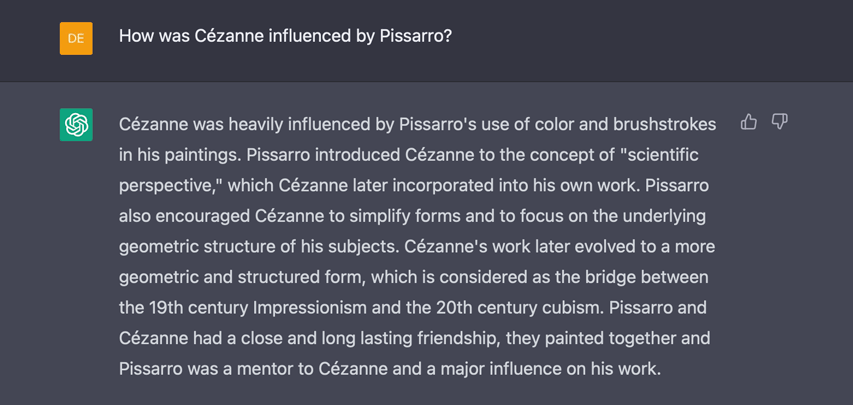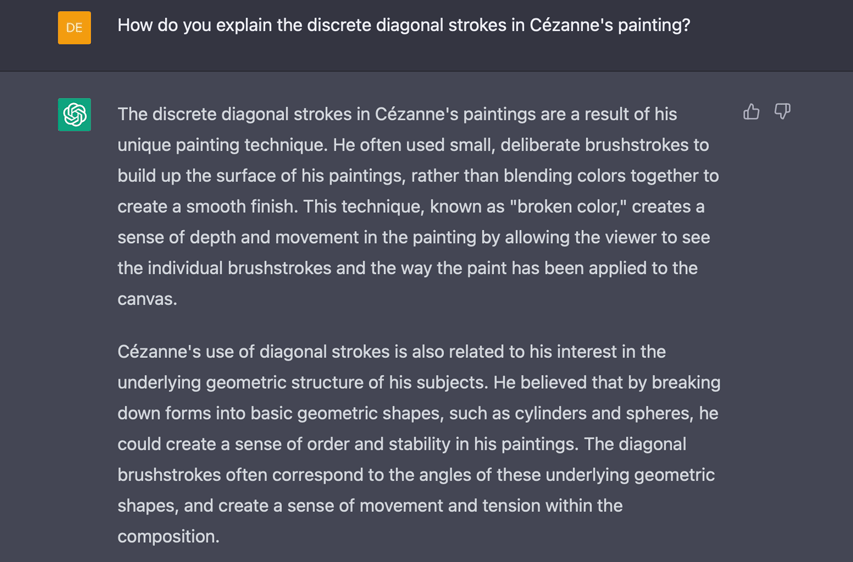January 20, 2023
First Contact with ChatGPT



Ok then.
I decided to ask the AI about a lingering question I had after seeing the Met's exhibition, Cubism and the Trompe l'Oeil Tradition
Q: How did the Cubists know so much about trompe l'oeil?
A: The Cubists, including artists such as Georges Braque and Pablo Picasso, were influenced by the technique of trompe l'oeil (which means "fool the eye" in French) in their work. Trompe l'oeil is a technique in which an artist creates the illusion of depth and three-dimensionality on a flat surface, often through the use of realistic details and shading.The Cubists were likely familiar with the technique of trompe l'oeil through their study of the works of earlier artists such as Jan van Eyck and Jan Vermeer, who were known for their highly detailed and realistic paintings. Additionally, the Cubists were also influenced by the work of the 19th-century French painter, Édouard Manet, who was known for his use of trompe l'oeil elements in his paintings.
Cubism, as an art movement, was heavily influenced by the idea of representing multiple viewpoints in a single painting. Trompe l'oeil, which creates the illusion of depth, was a way to represent the subject in a way that showed multiple viewpoints all at once. This idea of creating a new way of seeing and representing the world was also influenced by the advent of photography and the way that it changed the way we see the world.
The Cubists also had an interest in the concept of representation, and the ways in which art can depict the world. They were interested in pushing the boundaries of traditional representation, and trompe l'oeil technique allowed them to play with the viewer's perception of reality.
Overall, the Cubists' knowledge of trompe l'oeil was likely a result of their study of the works of earlier artists, as well as their interest in pushing the boundaries of traditional representation.
Q: What evidence do we have of the Cubists' knowledge of earlier trompe l'oeil art works?
A: There is evidence to suggest that the Cubists, particularly Georges Braque and Pablo Picasso, were familiar with and influenced by the technique of trompe l'oeil in the works of earlier artists.One example of this is the influence of the 15th century Flemish painters, such as Jan van Eyck and Jan Vermeer, on the Cubists. Both van Eyck and Vermeer were known for their highly detailed and realistic paintings, which often employed trompe l'oeil techniques to create the illusion of depth and three-dimensionality on a flat surface. The Cubists would have been exposed to these painters' work through exhibitions, art history books, and reproductions.
Another example is the influence of the 19th century French painter Édouard Manet on the Cubists. Manet's painting techniques and use of trompe l'oeil elements in his paintings, such as the use of light and shadow to create the illusion of depth, were highly admired by the Cubists.
Additionally, the Cubists' own works also provide evidence of their knowledge of trompe l'oeil techniques. For example, in Picasso's painting "Still Life with Chair Caning" (1912), the artist used trompe l'oeil elements, such as the illusion of a woven chair seat, to create a sense of depth and realism. In Georges Braque's "Violin and Palette" (1909-1910) the artist creates a sense of depth by using trompe l'oeil technique to make the palette and the violin look as if they are on top of the tablecloth.
Overall, the influence of earlier trompe l'oeil techniques can be seen in the works of the Cubists through their clear references, influences and incorporation of those techniques in their own paintings.
Q: Your answer "...trompe l'oeil techniques to create the illusion of depth and three-dimensionality on a flat surface." is not precise. Trompe l'oeil simultaneously creates and subverts the illusion of depth and three-dimensionality on flat surfaces. Please try to answer my question as to how the Cubists derived their knowledge of trompe l'oeil painting.
A: You are correct that the goal of trompe l'oeil is to create the illusion of depth and three-dimensionality on a flat surface while also subverting this illusion and drawing attention to the flatness of the painting surface.To answer your question, the Cubists, particularly Georges Braque and Pablo Picasso, were influenced by the technique of trompe l'oeil in their work by studying the works of earlier artists who used this technique. One of the main influences was the 15th century Flemish painters, such as Jan van Eyck and Jan Vermeer, who were known for their highly detailed and realistic paintings that employed trompe l'oeil techniques. The Cubists would have been exposed to these painters' work through exhibitions, art history books, and reproductions. They would have studied the techniques used by these artists to create the illusion of depth and three-dimensionality on a flat surface, and they would have learned how to subvert the illusion to draw attention to the flatness of the painting surface.
Another important influence on the Cubists was the 19th century French painter Édouard Manet, who was known for his use of trompe l'oeil elements in his paintings. Manet's painting techniques and use of trompe l'oeil elements, such as the use of light and shadow to create the illusion of depth, were highly admired by the Cubists.
Cubists also had an interest in the concept of representation, and the ways in which art can depict the world. They were interested in pushing the boundaries of traditional representation, and trompe l'oeil technique allowed them to play with the viewer's perception of reality and subvert it.
Overall, the Cubists' knowledge of trompe l'oeil was a result of their study of the works of earlier artists, as well as their interest in pushing the boundaries of traditional representation and subverting the viewer's perception of reality.
Q: Is there a historical record of Cubist artists conversations regarding trompe l'oeil?
A: While there is no direct historical record of specific conversations that Cubist artists, such as Georges Braque and Pablo Picasso, had regarding trompe l'oeil, there is evidence that they were familiar with and influenced by the technique through their own writings and statements, as well as through the analysis of their works.For example, Picasso and Braque's own works provide evidence of their knowledge of trompe l'oeil techniques. In Picasso's painting "Still Life with Chair Caning" (1912), the artist used trompe l'oeil elements, such as the illusion of a woven chair seat, to create a sense of depth and realism. In Georges Braque's "Violin and Palette" (1909-1910) the artist creates a sense of depth by using trompe l'oeil technique to make the palette and the violin look as if they are on top of the tablecloth.
There are also statements and writings by the artists that provide insight into their understanding of trompe l'oeil and its role in their work. For example, Picasso's statement "Art is a lie that makes us realize truth" suggest his interest in subverting reality and creating illusions through his art, something that is in line with the principles of trompe l'oeil.
Furthermore, there are also several art historian's and critic's analysis of the Cubist works that point to their knowledge and use of trompe l'oeil. These analysis often cite the similarities between the Cubist works and the works of earlier artists who used trompe l'oeil techniques such as Van Eyck and Vermeer, as well as the use of techniques such as the use of light and shadow to create the illusion of depth, as evidence of the cubist's knowledge of trompe l'oeil.
In summary, while there isn't a historical record of specific conversations between Cubist artists regarding trompe l'oeil, there is evidence of their knowledge and use of the technique through their works, statements and writings, and analysis of their works by art historians and critics.
*
*
*
Conclusion:
1) ChatGPT did not pass the Turing Test.
2) Jan van Eyck, Jan Vermeer and Édouard Manet were not trompe l'oeil painters.
3) I was looking for links to historical records of conversations, or recollections thereof between painters of that generation about the subject of trompe l'oeil.
No joy.
4) The citation of Picasso's "Lie > Truth" was spot on. Nice connection.
5) It's evident to me that the AI is faking it to make it. Kind of human, if you think about it.
Postscript: (aka slow on the uptake, Dennis) It just dawned on me that what I was looking for was to be pointed to sources where I can review conversations between artists of that period who were exploring Cubism. My frustration was that the AI wasn't delivering the goods. What this AI does is a butler function where it performs the searches and summarizes the results and what it doesn't do is provide the citations or bibliography of their search. Why is that and is there an AI service that is transparent? Is this opaqueness deliberate?
Here's the prompt to this realization:
...large language models have no concept of "truth"--they just know how to best complete a sentence in a way that's statistically probable based on their inputs and training set. So they make things up, and then state them with extreme confidence.From: Sam Willison's Weblog, Bing: I will not harm you unless you harm me first. It's worth reading for the report that the AI was surprisingly emotional and self aware... or at least it simulated this so.
If you haven't been paying attention, here's what's transpired so far. The demo was full of errorsPosted by Dennis at January 20, 2023 11:16 PM
It started gaslighting people
It suffered an existential crisis
The prompt leaked
And then it started threatening people
Leave a comment